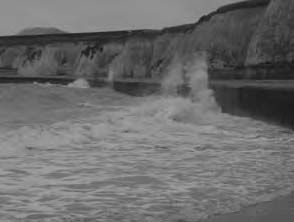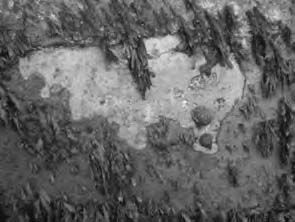|
For a mid-summer meeting, the weather on Saturday was disappointing. A very strong north easterly wind stopped the tide from going out as far as it should at Margate and made the sea very rough. A small party assembled at Sacketts Gap (TR373713): Ron Boyce, Rosemary Hill, Rupert Honnor, John and Richard Llewellyn-Jones, Robin Shrubsole and myself and worked out towards Foreness Point. The Margate chalk ledges are the largest in Europe. Foreness Point has vigorous tidal currents around it, carrying dead shells into Sandwich Bay. The Chalk ledges are eroded into runnels. On the top are beds of Mytilus edulis, with large numbers of brightly striped Nucella lapillus eating them. In the runnels there are millions of Littorina littorea, the other species of winkle were relatively rare. Lepidochitona cinereus was fairly common under stones. The soft Chalk is packed with live borers: Pholas dactylus, Barnea candida, Barnea parva, Petricola pholadiformis, Hiatella arctica, and there are dead Zirphaea crispata. Sabellaria worm tubes provided habitat for Graphis albida, Noemiamea dolioliformis, which were retrieved from microscopically-sorted samples. Although the tide did not go low enough to expose sandy areas where burrowing sea anemones might live (prey of Epitonium spp.) we were delighted to find large numbers of Epitonium clathratulum in strandline samples. Two non-native species were found: Crassostrea gigas and Ruditapes philippinarum, both are farmed at Whitstable 25 kilometres (15 miles) to the west. Live Abra alba and Donax vittattus were found in Palm Bay The next day we assembled at the new Sandwich Bay Bird Observatory Trust (SBBO) Field Centre. Rupert and Robin were replaced by Jan Light and two field Centre staff, Kelly O’Sullivan and Lynda Thyer. We were concentrating on finding live sand and mud species so we dug and sieved with gusto, following the tide down. We found live Abra alba, Macoma balthica, Fabulina fabula, Donax vittatus, Cerastoderma edule, Mactra stultorum, Spisula solida and Ensis arcuatus. The molluscs in the sand occurred about one per spadeful c.15cm x 10cm = 60/m2. It is interesting that the mid-shore tide lines accumulate large quantities of worm tubes, coal and dead shells. Sandwich Bay’s long shell species list is for mostly dead material and reflects the fact that they are derived from several habitats: Sandwich Bay itself, the muds of Pegwell Bay, salt-marsh and the Chalk. There is reputed to be a strong tidal current around Thanet which transports hard ground species into the Bay. One of the naturalists in the Field Centre was telling us that after the 1988 hurricane the Environment Agency brought in shiploads of submarine gravels from the Isle of Wight area to make up the gravel which had been lost. He thought that Pandora shells that are found occasionally might be derived from those imported gravels. Perhaps the occurrence of dead shells of Cerithiopisis pulchella (a Southern species whose distribution in the British Isles is focused around south western coasts) is also attributable to transport by this means. Engaging local people in conversation and tapping into such specialist knowledge is valuable in informing our interpretation of the species we find during fieldwork, and the anthropogenic movement of sediments around our coasts is a factor which needs to be considered in future when shell species turn up in areas which are disjunct from their known geographic range. A full list of species for both days can be found on the Society website. Recently Moerella donacina has been found twice by the previous SBOB Conservation Officer. It seems to be living in the Bay. This is an upgraded record for this area. Sandwich Bay and Pegwell Bay National Nature Reserve form a Site of Special Scientific Interest. The stabilised sand dunes and salt marshes have a wonderful flora and fauna and terns nest at the north end of the beach. We were warned to keep away from them! Quantities of lizard orchids were growing beside the road and were naturalised in gardens, fairly amazing! We were welcomed with drinks at the outset and when we got back from the beach more drinks and a wonderful fruit cake made for us by Kelly. We were made very welcome by the Centre director Kev Thornton, he showed us the interpretative centre, laboratory, lecture hall and accommodation for up to 20 people engaged in field work at the Bay. It is very, very nice, computer programs, artificial beaches, displays and a bookshop. Society members are welcome to work there. Look at the Website: www.sbbo.co.uk or telephone 01304 617341. |
Photos: John Llewellyn Jones |
Field Meeting Report: Thanet 25 - 26 June, 2005
Issue
9
Page
3




